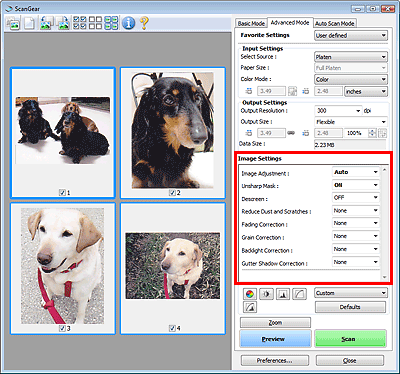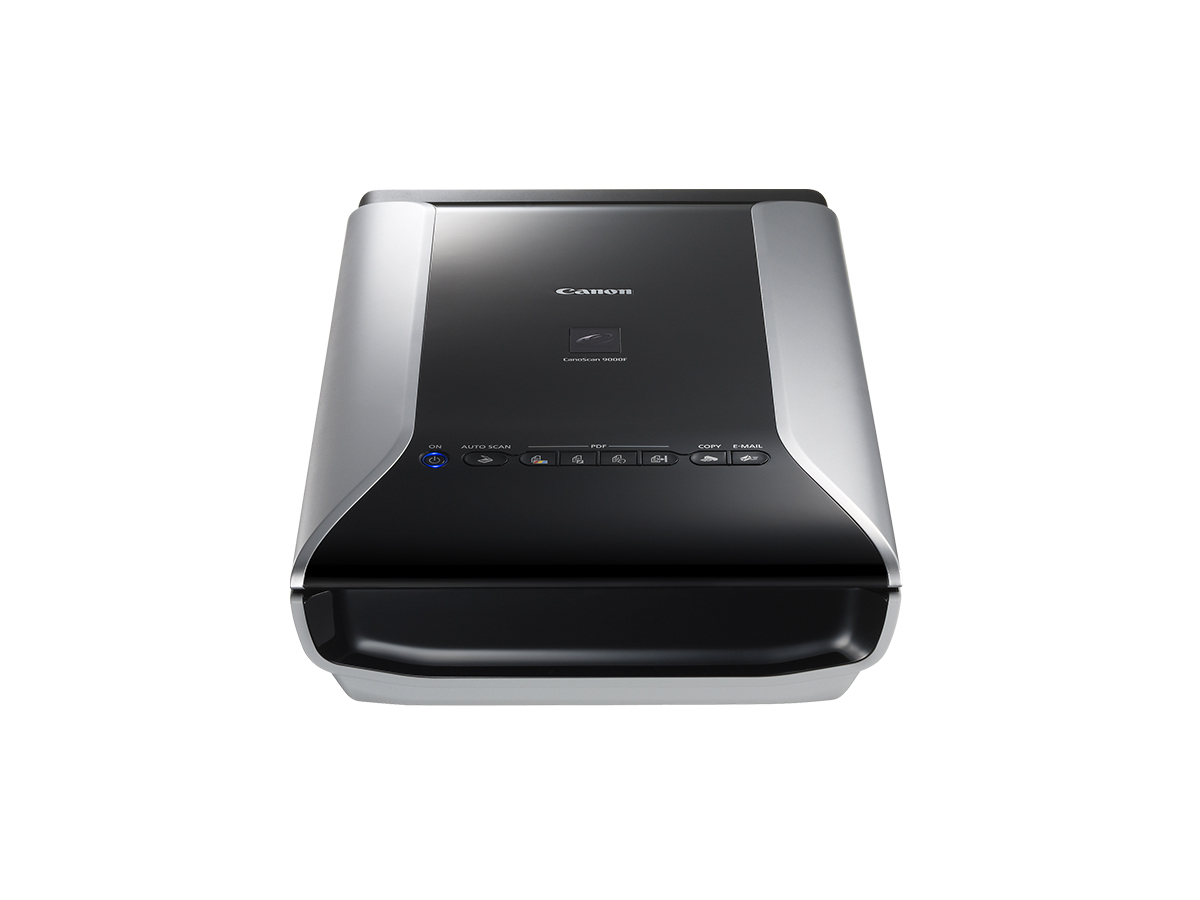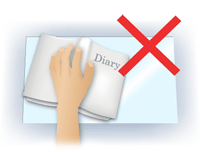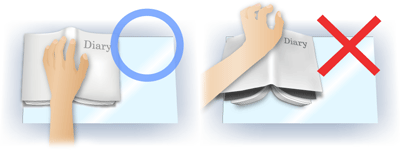Issue
Cause and solution
Check 1: Increase the scanning resolution
What is Resolution?
The data in the image you have scanned is a collection of dots carrying information about brightness and color. The density of these dots is called "resolution", and resolution will determine the amount of detail your image contains. The unit of resolution is dots per inch (dpi). Dpi is the number of dots per inch (2.54 cm).
The higher the resolution (value), the more detail in your image; the lower the resolution (value), the less detail.

Setting the Resolution in MP Navigator EX
In MP Navigator EX, you can specify the resolution with Scanning Resolution in the Scan Settings dialog box.
Documents to be viewed on a display should be scanned at 150 dpi, which is close to the resolution of a standard monitor.
For film, set the resolution to 600 dpi since images are enlarged approximately four times their original size when scanned.
Images to be printed should be scanned at a resolution that corresponds to the resolution of the printer.
For example, if you want to print documents using a 600 dpi black and white printer, you should set the resolution to 600 dpi. For film, set to 2400 dpi since images are enlarged approximately four times their original size when scanned.
With a color printer, specifying the resolution at half the resolution of the printer should be fine. For example, if you want to print using a 600 dpi color printer, you should set the resolution to 300 dpi for documents and 1200 dpi for film. However, with a high-resolution printer, printing takes longer than usual if you set the resolution to half the resolution of the printer.
If you print a document at twice the size both vertically and horizontally, the resolution of the document will be reduced by half. If the resolution of the original document is 300 dpi, the resolution of the enlarged document will be 150 dpi. If you print the document with a 600 dpi color printer, the lack of detail in the image may be obvious. In that case, if you scan at the Scanning Resolution of 600 dpi, the resolution will be 300 dpi even if you double the size of document and you can print the document with sufficient quality. Conversely, if you print a document at half scale, it should be sufficient to scan at half the resolution.
When Printing Color Photos at Twice the Size
| Document resolution: 300 dpi
Scanning resolution: 600 dpi Scale: 200% | Print at twice the size
Scanning resolution/actual scanning resolution: 600 dpi | Printing resolution: 300 dpi |
When Printing Color Film at L Size
| Document resolution: 300 dpi Scanning resolution: 1200 dpi Scale: 400% | Print at four times the size Scanning resolution/actual scanning resolution: 1200 dpi | Printing resolution: 300 dpi |
Setting the Resolution in ScanGear (Scanner Driver)
In ScanGear, you can specify the resolution with Output Resolution in Output Settings on the Advanced Mode tab.
The scanning resolution is automatically set so that the value set in Output Resolution will be the resolution of the scanned image. If you set Output Resolution to 300 dpi and scan at twice the size, the document will be automatically scanned at 600 dpi, and the resolution of the scanned image will be 300 dpi. You can print the document with sufficient quality using a 600 dpi color printer.
When Printing L Size (8.9 cm x 12.7 cm) Photos at Twice the Size
| Document resolution: 300 dpi Output resolution: 300 dpi Scale: 200% | Scan at twice the size Actual scanning resolution: 600 dpi | Image resolution/printing resolution: 300 dpi |
When Printing 35 mm Color Film (2.4 cm x 3.6 cm) at L Size (8.9 cm x 12.7 cm)
| Document resolution: 300 dpi Output resolution: 300 dpi Scale: 400% | Scan at four times the size
Actual scanning resolution: 1200 dpi | Image resolution/printing resolution: 300 dpi |
Appropriate Resolution Settings
Set the resolution according to the use of the scanned image.
Caution
Although you can change Output Resolution in ScanGear, it is recommended that you scan at the default value.
For displaying on a monitor: 150 dpi
For printing: 300 dpi
When Output Size is set to Flexible in ScanGear's Advanced Mode tab (scale is 100%)
| Document | Use | Color Mode | Output Resolution |
| Film | Copying (Printing) | Color | 1200 dpi |
| Color photo | Copying (Printing) | Color | 300 dpi |
| Creating a postcard | Color | 300 dpi | |
| Saving to a computer | Color | 75 dpi-300 dpi | |
| Using on a website or attaching to e-mail | Color | 75 dpi-150 dpi | |
| Black and white photo | Saving to a computer | Grayscale | 75 dpi-300 dpi |
| Using on a website or attaching to e-mail | Grayscale | 75 dpi-150 dpi | |
| Text document | Copying | Color, Grayscale or Black and White | 300 dpi |
| Attaching to e-mail | Color, Grayscale or Black and White | 150 dpi | |
| Scanning text using OCR | Color or Grayscale | 300 dpi-400 dpi |
Caution
If you double the resolution, the file size quadruples. If the file is too large, the processing speed will slow down significantly, and you will experience inconvenience such as lack of memory. Set the minimum required resolution according to the use of the image.
Cause and solution
Check 2: Set the scale to 100%
Some applications do not display images clearly if the image is too small.
Cause and solution
Check 3: Update the calibration data
Recalibrate the scanner from the Scanner tab in the Preferences dialog box of ScanGear (scanner driver). Calibration may take time depending on your computer.
Cause and solution
Check 4: If moire (stripe pattern) appears, take the following measures and scan again
-⋗ [ Image Settings ]
Caution
If moire appears when you scan a digital print photo, take the above measures and scan again.
Cause and solution
Cause and solution
Check 5: Check the monitor's color depth
From the Start menu, select Control Panel ⋗ Appearance and Personalization ⋗ Adjust screen resolution ⋗ Preferences.
On the Monitor tab of the displayed dialog box, set Colors to High Color (16 bit), True Color (24 bit) or True Color (32 bit).
From the Start menu, select Control Panel ⋗ Appearance and Personalization ⋗ Adjust screen resolution to open the Display Settings dialog box. Set the color depth to Medium (16 bit) or Highest (32 bit).
From the Start menu, select Control Panel ⋗ Display to open the Display Properties dialog box. On the Settings tab, set Colors to Medium (16 bit) or Highest (32 bit).
From the Start menu, select Settings ⋗ Control Panel ⋗ Display to open the Display Properties dialog box. On the Settings tab, set Colors to High Color (16 bit) or True Color (32 bit).
In the System Preferences screen, click the Displays icon, then in the Colors of the Display tab, select Thousands or Millions.
Cause and solution
Check 6: Clean the Platen and Document Cover
Clean the Platen of the scanner or the light source of the Film Adapter Unit, taking special care not to press strongly on the Platen.
Cause and solution
Check 7: If the document is in poor condition (dirty, faded, etc.), use Reduce Dust and Scratches, Fading Correction, Grain Correction, etc. in Image Settings on the Advanced Mode tab of ScanGear

Caution
Caution
Image Settings allows you to set the following items:
Caution
The setting items vary depending on whether Select Source is Platen or film.
Image Adjustment
When Image Adjustment is set, the brightness of the specified portion of the image is optimized. Images can be adjusted according to the automatically detected document type or the specified document type. The result of the adjustment will be reflected in the entire image.
Image Adjustment will not be applied.
Applies Image Adjustment by automatically detecting the document type. It is recommended that you normally select this setting.
Applies Image Adjustment suitable for photos and film.
Applies Image Adjustment suitable for magazines.
Applies Image Adjustment suitable for newspapers.
Applies Image Adjustment suitable for text documents.
Caution
Caution
Unsharp Mask
When this is set to ON, the outline of the subjects is emphasized to sharpen the image.
Descreen
Printed photos and pictures are displayed as a collection of fine dots. "Moire" is a phenomenon where uneven gradation or a stripe pattern appears when such photos or pictures printed with fine dots are scanned. Descreen is the function for reducing this moire effect.
Caution
Reduce Dust and Scratches
Scanned photos may contain white dots caused by dust or scratches. Use this function to reduce such noise.
Dust and scratches will not be reduced.
Select this to reduce small dust particles and scratches. Large ones may remain.
It is recommended that you normally select this setting.
Select this to reduce small/large dust particles and scratches. Evidence of the reduction process may remain and may also remove delicate parts of the image.
Caution
This function may not be effective for some types of photos.
Caution
It is recommended that you select None when scanning printed materials.
Remove Dust and Scratches (FARE) (Film only)
Removes dust and scratches automatically when scanning film.
Dust and scratches will not be removed.
Select this to remove major dust and scratches. Large ones may remain.
It is recommended that you normally select this setting.
Select this to remove minor dust and scratches as well. Evidence of the removal process may remain when large dust and scratches are removed.
Caution
Caution
When the resolution is set to 4801 dpi or higher and the Remove Dust and Scratches (FARE) checkbox is selected, scanning takes longer than usual. Also, make sure that there is sufficient free hard disk space before scanning.
Fading Correction
Use this function to correct photos and film that have faded with time or have a colorcast. Colorcast is a phenomenon where a specific color affects the entire picture due to the weather or ambient strong colors.
Fading correction will not be applied.
Select this to correct a small amount of fading and colorcast.
It is recommended that you normally select this setting.
Select this to correct a large amount of fading and colorcast. This can affect the tone of the image.
Caution
Grain Correction
Use this function to reduce graininess (roughness) in photos taken with high-speed or sensitized film.
Graininess will not be reduced.
Select this when the photo is slightly grainy.
It is recommended that you normally select this setting.
Select this when the photo is very grainy. This can affect the gradation and sharpness of the image.
Caution
Grain Correction may not be effective if the scan area is too small.
Backlight Correction
Use this function to correct photos and film that have been shot against light.
When you change the Backlight Correction setting, the result will be reflected in the preview image.
Backlight correction will not be applied.
Select this to correct slightly backlit photos. This will not affect the image contrast.
It is recommended that you normally select this setting.
Select this to correct strongly backlit photos. This can affect the image contrast.
Caution
Caution
Noise patterns may appear when Backlight Correction is applied. Applying Grain Correction and setting Unsharp Mask to OFF may reduce the noise patterns.
Gutter Shadow Correction
Use this function to correct shadows that appear between pages when scanning open booklets.
When you set the Gutter Shadow Correction setting in the preview image, the result will be reflected. Preview the effects before scanning, as results vary depending on the type of document and how it is pressed.
Unclear or blurred text/lines caused by curved pages are not corrected.
Gutter shadow will not be corrected.
Select this when the effect level is too strong with the medium setting.
It is recommended that you normally select this setting.
Select this when the effect level is too weak with the medium setting.
Caution
How to place the document depends on your model and the document to be scanned.
Caution
Exposure/Tone Settings (Film only)
This function enables you to adjust the exposure data according to the film.
When this checkbox is not selected, the optimal exposure data (the exposure level for each RGB channel and compensation levels) is automatically set according to the color density of the portion within the cropping area of the film.
Select this checkbox if you intend to adjust the image using an application after it is scanned or to scan with an under-exposed or over-exposed effect.
After you select this checkbox, you can adjust the exposure in 1% increments within the range of 50% to 200%.
Caution
This setting is not available when Apply the tone value to all frames / Apply the tone value to all crops is applied.
Caution
"All frames" is displayed in thumbnail view, and "All crops" is displayed in whole image view.
Click Apply to reflect the color adjustment data of the selected film frame or the portion within the selected cropping frame into other frames. This color adjustment data will be used in subsequent scans. It will remain in effect until you click Reset.
This is useful when you want to scan film of photos taken on the same day in the same place, in a consistent color tone.
Set to ON to improve the image quality and reduce noise when scanning film.
Caution
Cause and solution
Check 8: If the color tone of images is different from the original document, take the following measures and scan again
-⋗ [ Image Settings ]









